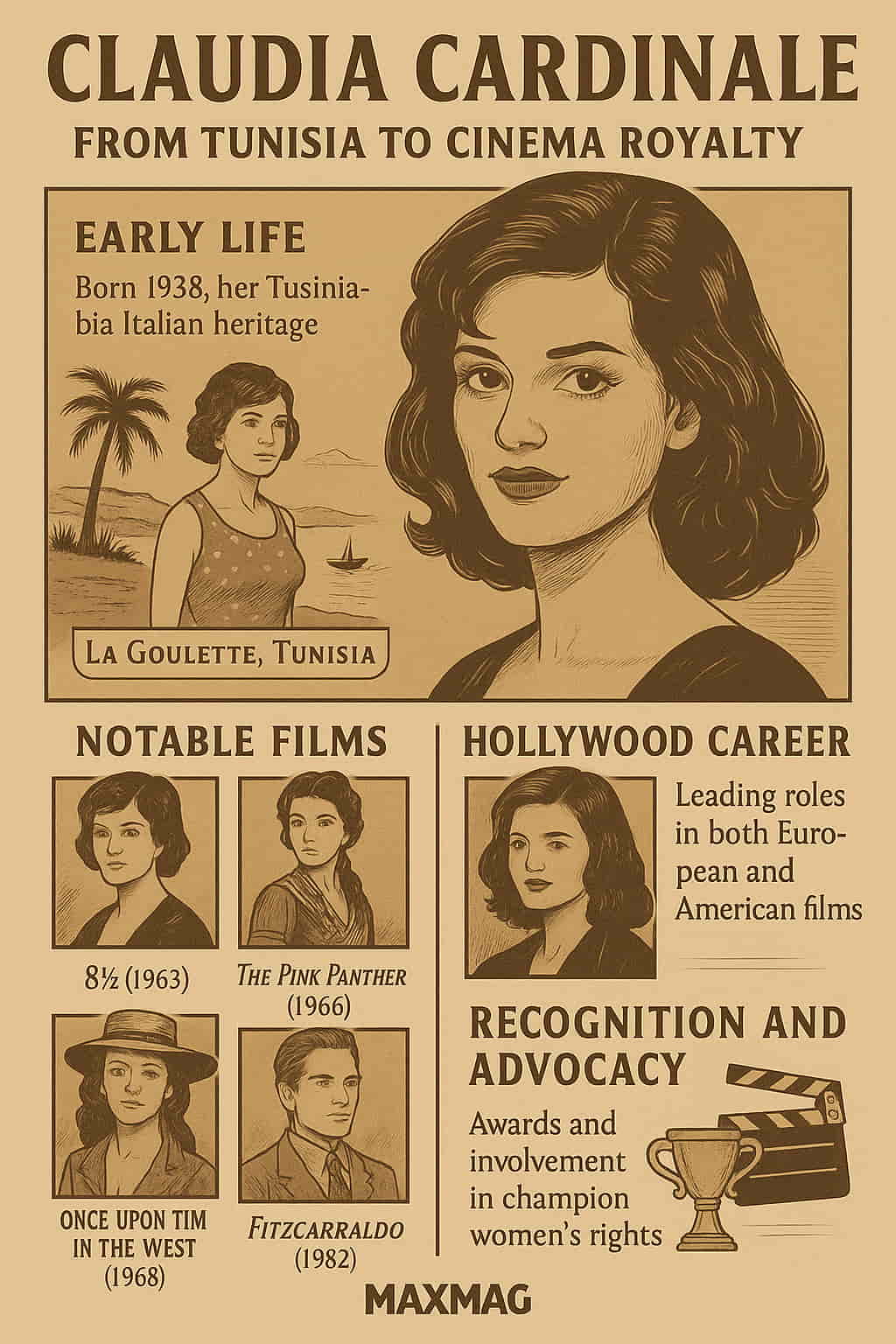
Few actresses in the history of cinema embody elegance, strength, and mystery quite like Claudia Cardinale. Born in Tunisia, raised by Italian parents, and embraced by both European auteurs and Hollywood heavyweights, Cardinale remains a symbol of classic cinema whose influence spans continents and decades. In this Claudia Cardinale biography, we uncover the multifaceted journey of a woman who lived on her own terms—resisting the mold while shaping cinematic history.
Claudia Cardinale Biography – Early Life and Roots in Tunisia
Claudia Cardinale was born Claude Joséphine Rose Cardinale on April 15, 1938, in La Goulette, a multicultural port town in French-ruled Tunisia. Her father, a railway worker, and her mother, born in Tunisia to Sicilian parents, maintained strong Italian roots. The Cardinale household was multilingual—Italian was spoken at home, but Claudia also grew up fluent in French and Arabic.
Despite living in a French colony, Cardinale always identified as Italian, a connection that would later shape her cinematic path. Her earliest years were shaped by Tunisia’s cultural mosaic: Arabic music in the streets, French colonial architecture, and Catholic schooling. Yet, her introverted nature made her a reluctant performer. As a child, she often preferred reading or observing people from a distance rather than being the center of attention.
Her relationship with cinema was distant at first. She once told The Guardian in a retrospective interview that she never dreamed of becoming an actress. “I found the camera terrifying. I never wanted to speak in front of it. I was too shy.” That changed in 1957 when she won a beauty contest—The Most Beautiful Italian Girl in Tunisia—which came with a prize trip to the Venice Film Festival. There, producers were immediately taken by her stunning looks and enigmatic gaze.
Though hesitant, Cardinale eventually agreed to pursue film, signing a seven-year contract with Vides Films, the company of producer Franco Cristaldi, who would later become her partner. One condition she set early on: she wanted to finish her studies first. That insistence on education would remain part of her advocacy throughout life.
First Steps in Cinema and the Rise to Stardom
Claudia’s screen debut came with the French-Tunisian film Goha (1958), co-starring Egyptian icon Omar Sharif. Though it wasn’t a breakout success, it opened the door to Italy’s film scene. Her next appearance was more impactful: I Soliti Ignoti (Big Deal on Madonna Street, 1958), directed by Mario Monicelli, a major figure in Italian comedy.
Her big break, however, came with Luchino Visconti’s Rocco and His Brothers (1960), where she played the spirited Nadia, a prostitute torn between two brothers. Though her voice was dubbed—studio execs thought her French-Italian accent wasn’t marketable—her physical presence and emotional intensity were unmistakable.
Visconti would go on to describe her as “the sun in the room.” Her talent for expressing emotion without words—a glance, a breath, a raised eyebrow—set her apart from the more overtly glamorous stars of the time.
Cardinale’s early 1960s success coincided with the golden age of Italian cinema. Federico Fellini, Michelangelo Antonioni, and Vittorio De Sica were creating arthouse masterpieces that captured the existential turmoil and aesthetic evolution of postwar Europe. Cardinale soon found herself at the center of this cinematic revolution.
The Power of Stillness: 8½ and Auteur Cinema
Cardinale’s defining moment may well have come in Federico Fellini’s 8½ (1963), one of the most critically acclaimed films of the 20th century. In this surreal semi-autobiographical tale, she played “the ideal woman”—a dream figure in the tormented imagination of director Guido Anselmi (Marcello Mastroianni).
Despite limited screen time, her role was pivotal. Cardinale became a metaphor: the balance between chaos and calm, desire and security. Her performance is often cited by film scholars, including those at the American Film Institute, as a masterclass in conveying meaning through minimalism (source).
“She had that rare quality of presence that didn’t demand the scene—it absorbed it,” wrote critic Richard Brody in The New Yorker.
In an era where female roles were often shallow or dependent on their male counterparts, Cardinale carved a niche as the mysterious force—the woman who does not yield but inspires.
The Leap to Hollywood and Global Recognition
Cardinale’s transition to Hollywood wasn’t forced or hurried. Unlike Sophia Loren, who actively pursued U.S. fame, Cardinale moved fluidly between Italian, French, and English-language films. Her English-language debut came in The Pink Panther (1963), where she starred opposite David Niven and Peter Sellers. As Princess Dala, she was elegant and enigmatic, drawing attention even amid the film’s comedic madness.
But it was Once Upon a Time in the West (1968), directed by Sergio Leone, that immortalized her internationally. As Jill McBain, a newly widowed former prostitute determined to claim her land in a ruthless frontier, Cardinale broke every mold Hollywood had created for women in Westerns.
She was not just the love interest or the damsel in distress—she was the film’s moral core. Her strength, sexuality, and pain were portrayed without sentimentality. The British Film Institute later ranked her character among the top female performances in film history (source).
Cardinale also appeared in Circus World (1964) with John Wayne and The Professionals (1966) with Burt Lancaster. Though these roles increased her U.S. visibility, she often declined major Hollywood contracts that would have required her to relocate to Los Angeles. Instead, she chose artistic freedom over commercial security.
Refusing the Mold: Feminism, Identity, and the Private Life
Despite the attention surrounding her beauty, Cardinale was never comfortable being sexualized. Early in her career, photographers wanted seductive poses, but she resisted. She didn’t strip on screen. She avoided scandal. And she rarely discussed her private life.
Still, her biography is full of profound personal trials. At 19, she became pregnant after a brief relationship. Studio executives feared the news would ruin her budding career and pressured her to keep the child—and the identity of the father—secret. Her son, Patrick, was presented to the public as her younger brother until she eventually revealed the truth years later.
This experience deeply influenced her views on female autonomy. In 2000, she became a UNESCO goodwill ambassador, advocating for women’s rights and education in the Arab world. She has spoken at multiple United Nations conferences on the need to empower young women to make choices free of shame or fear (source).
She once said, “I was a rebel without knowing it. I simply refused to do what didn’t feel right.” In a male-dominated industry, that in itself was radical.
The Later Years: Character Roles, Awards, and Enduring Grace
By the 1980s, Cardinale had transitioned to more character-driven roles. One of her standout later performances came in Fitzcarraldo (1982), Werner Herzog’s audacious adventure film about a man trying to bring opera to the Amazon jungle. Though her screen time was brief, her performance brought heart to an otherwise male-centric epic.
She continued acting throughout the 1990s and 2000s, often in French and Italian television and cinema. In 2010, she appeared in the romantic drama A Farewell to Fools, and in 2017, at age 79, she starred in Niente di Serio, proving her magnetism remained intact.
Throughout her career, Cardinale received numerous honors:
-
Golden Lion for Lifetime Achievement at the Venice Film Festival (1993)
-
Legion of Honour, France’s highest award (1998)
-
Honorary Golden Bear at the Berlin International Film Festival (2002)
-
Featured on the official poster of the 2017 Cannes Film Festival
Even today, she attends festivals and speaks about preserving cinema heritage and gender equality in film. Her refusal to surgically alter her appearance became part of her philosophy: aging naturally, she says, is an act of self-respect.
Cultural Legacy: The Woman Who Didn’t Conform
Claudia Cardinale wasn’t just an actress—she was a movement. Her career tells the story of a woman who refused to be defined by one nation, one language, one archetype. Her films straddle genres: neorealism, spaghetti westerns, surrealist epics, and romantic comedies.
In fashion, she became an icon of natural elegance. Unlike her contemporaries who embraced haute couture flamboyance, Cardinale often appeared in tailored, understated outfits that emphasized her Mediterranean beauty without spectacle. Vogue once called her style “aristocratic without being aristocratic.”
Film historians today often compare her career to that of Jeanne Moreau and Anna Karina—women who weren’t just actresses but thinkers, cultural symbols, and change-makers.
Even Martin Scorsese, in a tribute to Italian cinema, listed Cardinale as “the face of European resistance to Hollywood conformity.”
❓ Claudia Cardinale Biography: FAQ
Q: When and where was Claudia Cardinale born?
A: She was born April 15, 1938, in La Goulette, Tunis, then part of French Tunisia.
Q: What is Claudia Cardinale best known for?
A: Iconic roles in 8½, The Pink Panther, and Once Upon a Time in the West. She is known for her balance of strength and vulnerability on screen.
Q: Did she ever marry?
A: No. She had a long partnership with producer Franco Cristaldi but never legally married.
Q: What activism is she known for?
A: Women’s rights, education for girls in the Mediterranean and Arab regions, and freedom of expression in cinema.
Q: Is she still alive and active today?
A: Yes, Claudia Cardinale continues to appear at film festivals and is active in cinema-related advocacy work.







